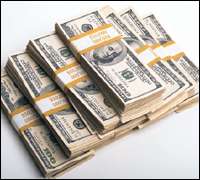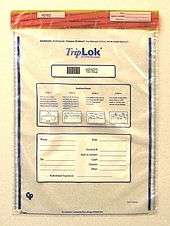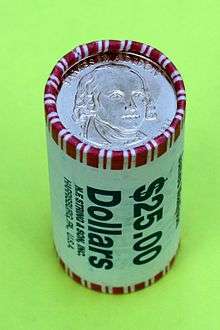Currency packaging
Currency packaging includes several forms of packing money for easy handling and counting. Many systems use standard color-coding or are marked to indicate the amount in the package.
Currency straps

Currency straps, also known as currency bands or bill straps, are a type of fastener used to secure discrete numbers of bills. Typically, currency bands have attached ends so bills are "curled" and slipped into the band whereas currency straps contain adhesive on the ends to secure them around the bills after wrapping.
Currency vacuum packaging
Generated bundles are packed together in groups of 10 (1000 banknotes) and vacuumized. A cliche print containing bank and branch details is applied to the plastic package seal. Vacuum packing is the most reliable and effective way of storing currency units, enabling the currency to be protected against tarnishing, such as from moisture and dirt. Vacuum packed banknotes also take up less space in containers used during cash transportation. Currency units are vacuum packed by means of a vacuum sealer.
Currency Bags

Bags used to hold a specific amount of paper currency. Usually tamper evident, and has labels to make notes on the front.
Coin bags
Bags used to hold a specific number of coins.
Coin wrappers

Tubes used to hold a specific number of coins.
Currency trays
Trays used to handle currency, often sorting by denomination.
See also
References
- Yam, K.L., "Encyclopedia of Packaging Technology", John Wiley & Sons, 2009, ISBN 978-0-470-08704-6
- Soroka, W, Illustrated Glossary of Packaging Terminology Institute of Packaging Professionals,
| Wikimedia Commons has media related to Currency packaging. |